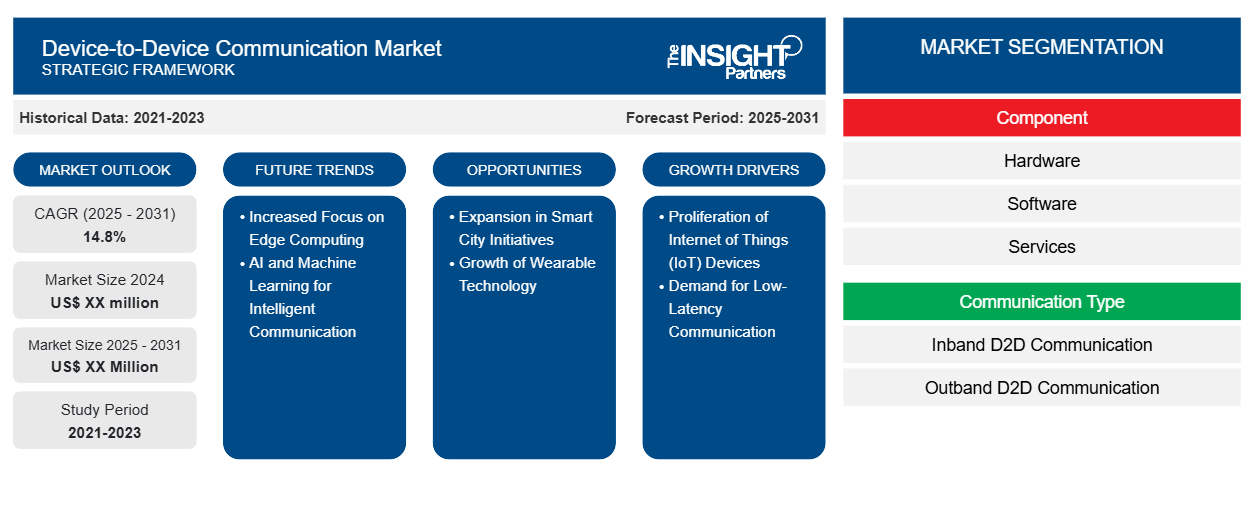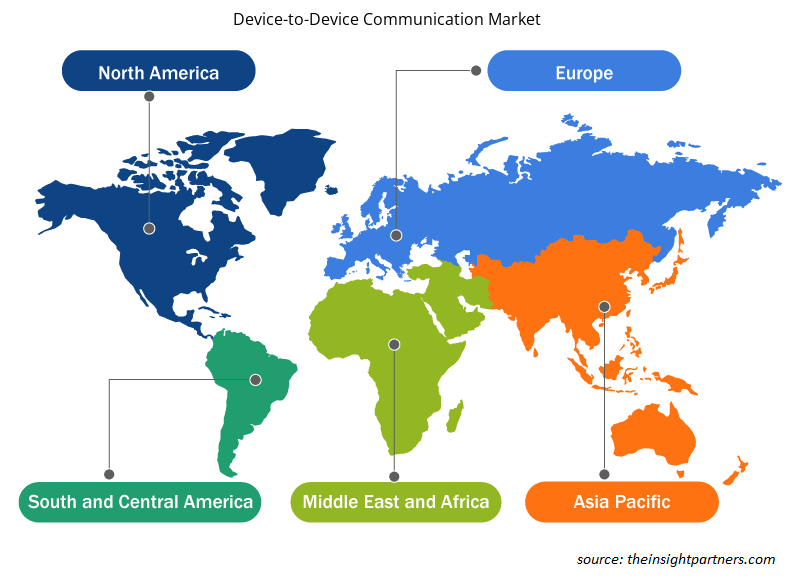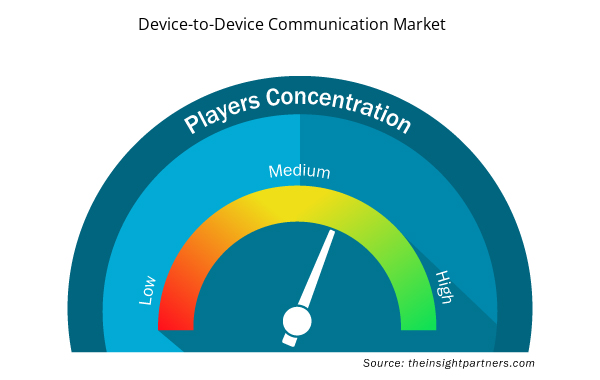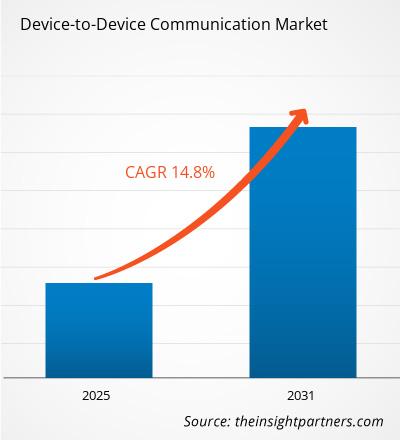预计 2025 年至 2031 年期间设备到设备通信市场复合年增长率为 14.8%,市场规模将从 2024 年的 XX 百万美元扩大到 2031 年的 XX 百万美元。
报告按组件(硬件、软件、服务)细分;通信类型(带内 D2D 通信、带外 D2D 通信);应用(车对车 (V2V) 通信、公共安全服务、内容分发、蜂窝卸载、其他);地理区域(北美、欧洲、亚太地区、中东和非洲、南美和中美洲)。
全球分析进一步细分为区域和主要国家。报告以美元为单位提供上述分析和细分的价值
报告目的
Insight Partners 发布的《设备到设备通信市场》报告旨在描述当前形势和未来增长、主要驱动因素、挑战和机遇。这将为各种业务利益相关者提供见解,例如:
- 技术提供商/制造商:了解不断变化的市场动态并了解潜在的增长机会,从而能够做出明智的战略决策。
- 投资者:对市场增长率、市场财务预测以及整个价值链中存在的机会进行全面的趋势分析。
- 监管机构:监管市场政策和警察活动,旨在最大限度地减少滥用行为,维护投资者的信任和信心,维护市场的完整性和稳定性。
设备到设备通信市场细分
成分
- 硬件
- 软件
- 服务
通信类型
- 带内 D2D 通信
- 带外 D2D 通信
应用
- 车对车通信
- 公共安全服务
- 内容分发
- 蜂窝卸载
- 其他的
地理
- 北美
- 欧洲
- 亚太
- 南美洲和中美洲
- 中东和非洲
定制此报告以满足您的需求
您可以免费定制任何报告,包括本报告的部分内容、国家级分析、Excel 数据包,以及为初创企业和大学提供优惠和折扣
设备到设备通信市场:战略洞察

- 获取此报告的关键市场趋势。这个免费样品将包括数据分析,从市场趋势到估计和预测。
设备到设备通信市场的增长动力
- 物联网 (IoT) 设备的激增:物联网设备的快速扩张是设备到设备 (D2D) 通信市场的主要驱动力。随着越来越多的设备实现互联,从智能家电和可穿戴设备到工业传感器和车辆,这些设备之间的高效通信需求变得至关重要。D2D 通信可实现无缝数据交换、增强响应能力并支持实时决策,使其成为物联网生态系统的重要组成部分。物联网设备数量的增加大大推动了对 D2D 通信解决方案的需求。
- 低延迟通信需求:随着需要实时数据交换的应用(例如自动驾驶汽车、智能城市和增强现实 (AR) 体验)的兴起,对低延迟通信的需求也日益增长。D2D 通信可使设备直接相互通信,而无需通过中央服务器路由数据,从而减少与传统网络通信相关的延迟。此功能对于需要即时响应和高可靠性的应用至关重要,从而推动了 D2D 通信技术的采用。
设备对设备通信市场未来趋势
- 更加关注边缘计算:边缘计算趋势正在影响 D2D 通信市场,因为它使数据处理更接近数据生成源。这种转变减少了延迟和带宽使用,同时增强了 D2D 通信的实时功能。在边缘计算环境中,设备可以直接相互通信以立即做出决策,而无需依赖集中式云服务器。这一趋势正在推动利用边缘计算架构来提高性能的 D2D 通信解决方案的发展。
- 人工智能和机器学习助力智能通信:人工智能和机器学习 (ML) 正在融入 D2D 通信系统,以提高效率和决策能力。通过让设备从交互中“学习”,这些技术可以优化通信路径、预测潜在故障并增强数据处理能力。人工智能/机器学习驱动的系统还可以实现设备之间的自主决策,从而为智能家居、工业物联网和医疗保健设备打造更具适应性和智能的网络。
设备到设备通信市场机会
- 智慧城市计划的扩展:智慧城市的概念在全球范围内越来越受欢迎,为 D2D 通信技术提供了重大机遇。随着城市地区寻求改善基础设施、提高效率并为市民提供更好的服务,D2D 通信可以促进各种城市服务和设备的互连,例如交通管理系统、公共交通和能源网。开发针对智慧城市应用(包括实时监控和自动响应系统)量身定制的 D2D 解决方案的供应商可以利用这一日益增长的趋势。
- 可穿戴技术的发展:健身追踪器、智能手表和健康监测设备等可穿戴设备日益普及,为 D2D 通信创造了新的机会。可穿戴技术通常依赖于设备之间的快速数据交换,以实现健康监测、通知和健身追踪等功能。通过实现可穿戴设备与其他连接设备(如智能手机或家庭自动化系统)之间的高效通信,D2D 通信可以增强用户体验,并推动可穿戴技术在医疗保健和健身等各个领域的应用。
设备到设备通信市场区域洞察
Insight Partners 的分析师已详尽解释了预测期内影响设备到设备通信市场的区域趋势和因素。本节还讨论了北美、欧洲、亚太地区、中东和非洲以及南美和中美洲的设备到设备通信市场细分和地理位置。

- 获取设备对设备通信市场的区域特定数据
设备到设备通信市场报告范围
| 报告属性 | 细节 |
|---|---|
| 2024 年的市场规模 | XX 百万美元 |
| 2031 年市场规模 | XX 百万美元 |
| 全球复合年增长率(2025 - 2031) | 14.8% |
| 史料 | 2021-2023 |
| 预测期 | 2025-2031 |
| 涵盖的领域 | 按组件
|
| 覆盖地区和国家 | 北美
|
| 市场领导者和主要公司简介 |
|
设备到设备通信市场参与者密度:了解其对业务动态的影响
设备到设备通信市场正在快速增长,这得益于终端用户需求的不断增长,这些需求源于消费者偏好的不断变化、技术进步以及对产品优势的认识不断提高等因素。随着需求的增加,企业正在扩大其产品范围,进行创新以满足消费者的需求,并利用新兴趋势,从而进一步推动市场增长。
市场参与者密度是指在特定市场或行业内运营的企业或公司的分布情况。它表明在给定市场空间中,相对于其规模或总市场价值,有多少竞争对手(市场参与者)存在。
在设备到设备通信市场运营的主要公司有:
- 爱立信电信
- 英特尔公司
- 德州仪器公司
- 高通
- 罗德与施瓦茨
免责声明:上面列出的公司没有按照任何特定顺序排列。

- 获取设备到设备通信市场顶级关键参与者概览
主要卖点
- 全面覆盖:报告全面涵盖了设备到设备通信市场的产品、服务、类型和最终用户的分析,提供了整体概况。
- 专家分析:报告基于对行业专家和分析师的深入了解而编写。
- 最新信息:该报告涵盖了最新信息和数据趋势,确保了其与业务的相关性。
- 定制选项:此报告可以定制以满足特定客户要求并恰当地适应业务策略。
因此,设备到设备通信市场研究报告有助于引领解读和了解行业情景和增长前景。尽管可能存在一些合理的担忧,但本报告的总体优势往往大于劣势。
- 历史分析(2 年)、基准年、预测(7 年)及复合年增长率
- PEST 和 SWOT 分析
- 市场规模价值/数量 - 全球、区域、国家
- 行业和竞争格局
- Excel 数据集


- Aquaculture Market
- Blood Collection Devices Market
- Hot Melt Adhesives Market
- Rare Neurological Disease Treatment Market
- Pharmacovigilance and Drug Safety Software Market
- Hydrolyzed Collagen Market
- Medical and Research Grade Collagen Market
- 3D Mapping and Modelling Market
- Smart Parking Market
- Water Pipeline Leak Detection System Market

Report Coverage
Revenue forecast, Company Analysis, Industry landscape, Growth factors, and Trends

Segment Covered
This text is related
to segments covered.

Regional Scope
North America, Europe, Asia Pacific, Middle East & Africa, South & Central America

Country Scope
This text is related
to country scope.
常见问题
Some of the customization options available based on the request are an additional 3-5 company profiles and country-specific analysis of 3-5 countries of your choice. Customizations are to be requested/discussed before making final order confirmation# as our team would review the same and check the feasibility
The report can be delivered in PDF/PPT format; we can also share excel dataset based on the request
Increased Focus on Edge Computing is anticipated to play a significant role in the global Device-to-Device Communication Market in the coming years
Proliferation of Internet of Things (IoT) Devices and Demand for Low-Latency Communication are the major factors driving the Device-to-Device Communication Market
The Device-to-Device Communication Market is estimated to witness a CAGR of 14.8% from 2023 to 2031
Trends and growth analysis reports related to Technology, Media and Telecommunications : READ MORE..
1.Telefonaktiebolaget LM Ericsson
2.Intel Corporation
3.Texas Instruments Incorporated
4.Qualcomm
5.Rohde and Schwarz
6.Samsung
7.Huawei Technologies
8.Nokia Corporation
9.Google LLC
10.Microsoft Corporation
The Insight Partners performs research in 4 major stages: Data Collection & Secondary Research, Primary Research, Data Analysis and Data Triangulation & Final Review.
- Data Collection and Secondary Research:
As a market research and consulting firm operating from a decade, we have published and advised several client across the globe. First step for any study will start with an assessment of currently available data and insights from existing reports. Further, historical and current market information is collected from Investor Presentations, Annual Reports, SEC Filings, etc., and other information related to company’s performance and market positioning are gathered from Paid Databases (Factiva, Hoovers, and Reuters) and various other publications available in public domain.
Several associations trade associates, technical forums, institutes, societies and organization are accessed to gain technical as well as market related insights through their publications such as research papers, blogs and press releases related to the studies are referred to get cues about the market. Further, white papers, journals, magazines, and other news articles published in last 3 years are scrutinized and analyzed to understand the current market trends.
- Primary Research:
The primarily interview analysis comprise of data obtained from industry participants interview and answers to survey questions gathered by in-house primary team.
For primary research, interviews are conducted with industry experts/CEOs/Marketing Managers/VPs/Subject Matter Experts from both demand and supply side to get a 360-degree view of the market. The primary team conducts several interviews based on the complexity of the markets to understand the various market trends and dynamics which makes research more credible and precise.
A typical research interview fulfils the following functions:
- Provides first-hand information on the market size, market trends, growth trends, competitive landscape, and outlook
- Validates and strengthens in-house secondary research findings
- Develops the analysis team’s expertise and market understanding
Primary research involves email interactions and telephone interviews for each market, category, segment, and sub-segment across geographies. The participants who typically take part in such a process include, but are not limited to:
- Industry participants: VPs, business development managers, market intelligence managers and national sales managers
- Outside experts: Valuation experts, research analysts and key opinion leaders specializing in the electronics and semiconductor industry.
Below is the breakup of our primary respondents by company, designation, and region:

Once we receive the confirmation from primary research sources or primary respondents, we finalize the base year market estimation and forecast the data as per the macroeconomic and microeconomic factors assessed during data collection.
- Data Analysis:
Once data is validated through both secondary as well as primary respondents, we finalize the market estimations by hypothesis formulation and factor analysis at regional and country level.
- Macro-Economic Factor Analysis:
We analyse macroeconomic indicators such the gross domestic product (GDP), increase in the demand for goods and services across industries, technological advancement, regional economic growth, governmental policies, the influence of COVID-19, PEST analysis, and other aspects. This analysis aids in setting benchmarks for various nations/regions and approximating market splits. Additionally, the general trend of the aforementioned components aid in determining the market's development possibilities.
- Country Level Data:
Various factors that are especially aligned to the country are taken into account to determine the market size for a certain area and country, including the presence of vendors, such as headquarters and offices, the country's GDP, demand patterns, and industry growth. To comprehend the market dynamics for the nation, a number of growth variables, inhibitors, application areas, and current market trends are researched. The aforementioned elements aid in determining the country's overall market's growth potential.
- Company Profile:
The “Table of Contents” is formulated by listing and analyzing more than 25 - 30 companies operating in the market ecosystem across geographies. However, we profile only 10 companies as a standard practice in our syndicate reports. These 10 companies comprise leading, emerging, and regional players. Nonetheless, our analysis is not restricted to the 10 listed companies, we also analyze other companies present in the market to develop a holistic view and understand the prevailing trends. The “Company Profiles” section in the report covers key facts, business description, products & services, financial information, SWOT analysis, and key developments. The financial information presented is extracted from the annual reports and official documents of the publicly listed companies. Upon collecting the information for the sections of respective companies, we verify them via various primary sources and then compile the data in respective company profiles. The company level information helps us in deriving the base number as well as in forecasting the market size.
- Developing Base Number:
Aggregation of sales statistics (2020-2022) and macro-economic factor, and other secondary and primary research insights are utilized to arrive at base number and related market shares for 2022. The data gaps are identified in this step and relevant market data is analyzed, collected from paid primary interviews or databases. On finalizing the base year market size, forecasts are developed on the basis of macro-economic, industry and market growth factors and company level analysis.
- Data Triangulation and Final Review:
The market findings and base year market size calculations are validated from supply as well as demand side. Demand side validations are based on macro-economic factor analysis and benchmarks for respective regions and countries. In case of supply side validations, revenues of major companies are estimated (in case not available) based on industry benchmark, approximate number of employees, product portfolio, and primary interviews revenues are gathered. Further revenue from target product/service segment is assessed to avoid overshooting of market statistics. In case of heavy deviations between supply and demand side values, all thes steps are repeated to achieve synchronization.
We follow an iterative model, wherein we share our research findings with Subject Matter Experts (SME’s) and Key Opinion Leaders (KOLs) until consensus view of the market is not formulated – this model negates any drastic deviation in the opinions of experts. Only validated and universally acceptable research findings are quoted in our reports.
We have important check points that we use to validate our research findings – which we call – data triangulation, where we validate the information, we generate from secondary sources with primary interviews and then we re-validate with our internal data bases and Subject matter experts. This comprehensive model enables us to deliver high quality, reliable data in shortest possible time.

 获取此报告的免费样本
获取此报告的免费样本